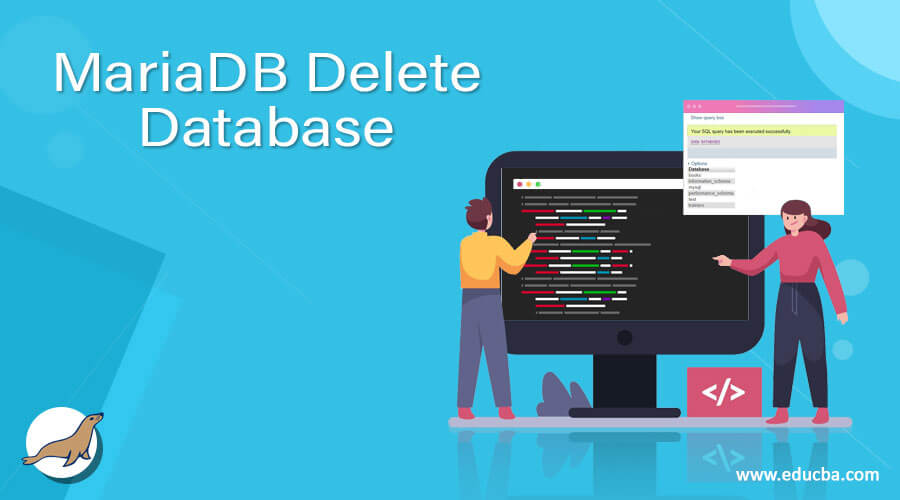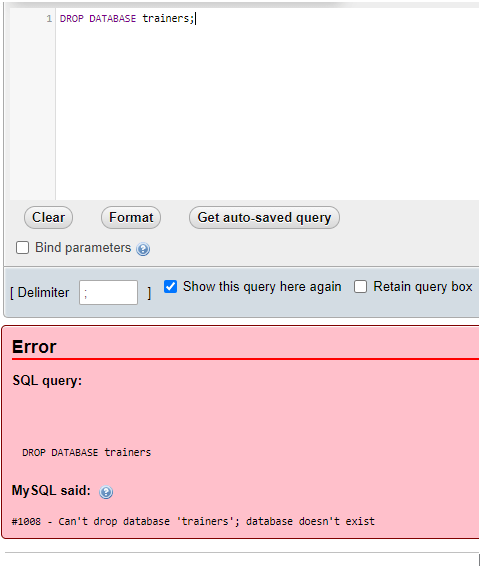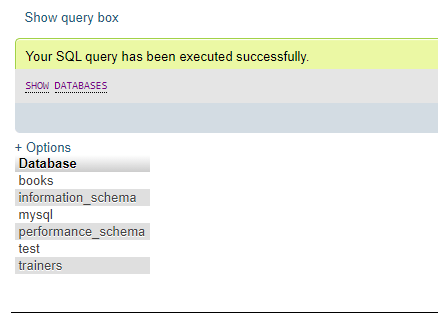Updated June 3, 2023

Definition on MariaDB Delete Database
- MariaDB Delete Database is a MariaDB administrative command that removes the specific database mentioned in the query with all its related tables and procedures.
- But for creating or deleting any databases in the MariaDB server, a user needs certain privileges normally associated with the admins or the root users. Here, these two accounts comprise two options to remove a database – the first is a PHP script, and the other is the mysqladmin binary.
- A user should be careful while performing some operations while using this command MariaDB Delete Database. Once the command gets executed, the removed databases are irretrievable, so exercise properly.
Syntax:
You can observe a simple elementary syntax structure code provided below:
DROP (DATABASE | SCHEMA) {IF EXISTS} Name_of_databaseLet us describe the above syntax terms used:
- DROP DATABASE works to drop all the available tables in the server database and then deletes the database. But to use this command a user requires the DROP privilege on the MariaDB database. Also, DROP SCHEMA functions as a synonym for the MariaDB DROP DATABASE command for deleting the database.
- But it should be noted that if a database is dropped, the user privileges on the server will not be deleted.
- The next term i.e., IF EXISTS term, is responsible to avoid an error from delivering after query execution for the databases which may not be currently available. Therefore, the MariaDB generates a NOTE for every non-existing database if the term IF EXISTS is implemented.
How to Delete a Database in MariaDB using various ways?
A user can perform the delete operation or even the create operation on any MariaDB database if the user holds the admin privileges or the root ones. These two accounts include two choices to delete a database in MariaDB: the mysqladmin binary and the PHP script.
Once the databases are deleted in MariaDB, we cannot recover them, so if not sure, take a backup if required for these databases or be careful while accomplishing this admin-level operation.
Let us view the two concepts of accounts in MariaDB:
Mysqladmin binary
The succeeding example illustrates how to implement the mysqladmin binary to remove an existent MariaDB database using the command below:
Firstly, you need to login to your phpmyadmin or through knowledge and type the Delete operation query as Drop Database technology;
Remember that if the mentioned name of the database does not exist, then it will reflect the error as ERROR 1008 (HY000): Can’t drop database ‘technology’; database doesn’t exist;
PHP Drop Database Script
PHP utilizes the mysql_query function to delete MariaDB databases. Here, the mysql_query function implements the two parameters where one is optional and will return the value as TURE or FLASE, true if the query executes and false if not.
View the following syntax for drop database script as Bool mysql_query(sql, connection);
The parameters used are described as below:
- SQL is the required parameter, including the SQL query necessary to perform the operation.
- Connection is the optional parameter in the function which, when not particularized, applies the latest connection established.
Examples
For instances, let us discuss some of the MariaDB Delete Database queries explained as follows:
Drop Database Trainers;Output:

After the query execution, you can view that the MariaDB database will be removed. But again, if you try to run the same command on the server, you will receive an error as follows:
Drop Database Trainers;Output:

Here, you can observe that executing the query again, as previously, will result in an ERROR 1008 (HY000). This error indicates that the Drop command cannot be executed because the database with this name has already been deleted. Therefore, it will display that the same database does not exist in the MariaDB server for deletion.
You can also activate a warning to see what kind of error has occurred in the query execution by using the succeeding command:
SHOW WARNINGS ENABLEDFurther, to avoid the existent database error, you can use the SQL keyword as IF EXISTS to support the query and define that execute the query or perform deletion only if the specific MariaDB database is present otherwise, not. So, this kind of concept will work better for standard operations. Using this will avoid seeing any errors.
The command can be typed as:
Drop Database IF EXISTS trainers;Output:

It would be best to remember that code 1008 denotes the error for not dropping the database because it is unavailable. Before proceeding towards the deletion operation, a user can view all the existing databases present by using the command:
SHOW DATABASES;Output:

As you can see, the list displays the databases that are currently present.
Note that when removing the MariaDB database using the command line tool directly, exercise caution to ensure you delete the intended database. Removing the wrong database makes it challenging to undo the action and perform a backup. For MariaDB Delete database operation, the mysql-console may not be supportive here. But when everything performs well, it will produce a simple message as ‘OK’.
After the delete operation, you can re-check the server to see if the database is deleted using the same query as SHOW DATABASES.
Similarly, deleting a database in such an acquainted graphical interface as cpanel in hosting platforms can also be simple, including some options and visiting the wizard panel items in the cPanel server.
Conclusion
- The MariaDB Delete Database query command can be as simple as executing a single statement.
- This operation to remove the specific database is a non-reversible event and must be performed with caution. A user should be aware and ensure that they do not mistakenly remove the wrong MariaDB database from the server, as it cannot be recovered again.
- Therefore, it is often a better idea to perform create a backup operation of the database to reserve the old database to use if required in the future of that particular database.
Recommended Articles
We hope that this EDUCBA information on the “MariaDB Delete Database” was beneficial to you. You can view EDUCBA’s recommended articles for more information.

